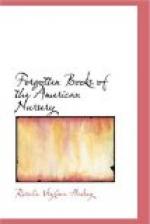This same criticism was made again and again about the style of American writers for adults, so that it is little wonder the children’s books received no unqualified praise. But Americanisms were not the worst feature of the “inundation of American children’s books,” which because of their novelty threatened to swamp the “higher class” English. They were feared because of the “multitude of false notions likely to be derived from them, the more so as the similarity of name and language prevents children from being on their guard, and from remembering that the representations that they read are by foreigners.” It was the American view of English institutions (presented in story-book form) which rankled in the British breast as a “condescending tenderness of the free nation towards the monarchical regime” from which at any cost the English child must be guarded. In this respect Peter Parley was the worst offender, and was regarded as “a sad purveyor of slip-slop, and no matter how amusing, ignorant of his subject.” That gentleman, meanwhile, read the criticisms and went on making “bread and butter,” while he scowled at the English across the water, who criticised, but pirated as fast as he published in America.
Gentle Miss Eliza Leslie received altogether different treatment in this review of American juvenile literature. She was considered “good everywhere, and particularly so for the meridian in which her tales were placed;” and we quite agree with the reviewer who considered it well worth while to quote long paragraphs from her “Tell Tale” to show its character and “truly useful lesson.” “To America,” continued this writer, “we also owe a host of little books, that bring together the literature of childhood and the people; as ‘Home,’ ‘Live and Let Live’ [by Miss Sedgwick], &c., but excellent in intention as they are, we have our doubts, as to the general reception they will meet in this country while so much of more exciting and elegant food is at hand.” Even if the food of amusement in England appeared to the British mind more spiced and more elegant, neither Miss Leslie’s nor Miss Sedgwick’s fictitious children were ever anaemic puppets without wills of their own,—a type made familiar by Miss Edgeworth and persisted in by her admirers and successors,—but vitalized little creatures, who acted to some degree, at least, like the average child who loved their histories and named her dolls after favorite characters.
To-day these English criticisms are only of value as showing that the American story-book was no longer imitating the English tale, but was developing, by reason of the impress of differing social forces, a new type. Its faults do not prevent us from seeing that the spirit expressed in this juvenile literature is that of a new nation feeling its own way, and making known its purpose in its own manner. While we smile at sedulous endeavors of the serious-minded writers to present their convictions, educational,




